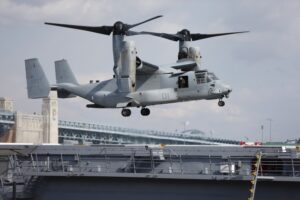
The investigation into yet another deadly crash of a U.S. military Osprey aircraft in late November is looking at a possible mishap involving the aircraft’s propeller rotor gear box, U.S. officials familiar with the preliminary findings say.
The accident, in which a U.S. Air Force V-22 Osprey crashed into the ocean off Japan, killing eight airmen, was the fourth fatal crash of the unique tiltrotor aircraft in less than two years. Twenty U.S. service members have died in the incidents, leading to a rare grounding in December of all Osprey aircraft by all branches of the U.S. military.
The cause of the crash off Japan is still under investigation and has not been established, according to those familiar with the investigation.
In a statement after initial publication of this article, a spokesperson for Air Force Special Operations Command told NBC News that investigations into the incident “are still actively in progress and analysis is ongoing to determine the cause of the mishap. At this time, the material failure that occurred is known but the cause of the failure has not been determined. … Any disclosure of findings prior to investigations being finalized is premature and presumptive.”
Ospreys can take off vertically like helicopters, but then tilt their two rotors to fly like dual propeller planes. The military has about 400 Ospreys that are used by the Navy, Marines and Air Force, though most are flown by the Marine Corps.
In the past the Ospreys sometimes had a problem called a “hard clutch engagement,” which in one June 2022 incident caused a crash that killed five Marines. In February 2023 the military said while they had still not determined a root cause for the hard clutch incidents, officials were 99% sure the clutch problem was fixed. The military’s joint program office for the aircraft told NBC News that the last of the 19 hard clutch engagements reported by all three service branches occurred in January 2023.
The Pentagon’s joint program office said in a statement that military leaders are working to provide service members “with the safest, most reliable aircraft possible. … The safety and well-being of our personnel and the reliability of the V-22 continues to be a priority in our discussions as we determine our return to flight plan.”
